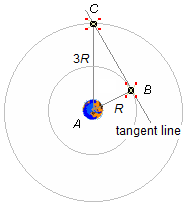Solved Problem on Kepler's Laws and Gravitation
advertisement
Two artificial satellites, S1 and S2 orbit the Earth in a circular motion at distances, respectively, equal to r1 = R and r2 = 3R from their center. At a certain instant, the line connecting the centers of the satellites is tangent to the orbit of S1. Determine at this instant the distance d between S1 and S2.
Problem data:
- Distance from satellite S1 to Earth: r1 = R;
- Distance from satellite S2 to Earth: r2 = 3R.

Solution
From Figure 1, we see that in the triangle ΔABC, segment \( \overline{AB} \) is the distance from satellite S1 to Earth, segment \( \overline{AC} \) is the distance from satellite S2 to Earth, segment \( \overline{BC} \) connects the centers of the two satellites and is tangent to the orbit of S1 and perpendicular to \( \overline{AB} \), therefore the triangle ΔABC is a right triangle and the distance between the two satellites d, segment \( \overline{BC} \), will be given by the Pythagorean Theorem, we have the legs \( \overline{AB}=R \), \( \overline{BC}=d \) and the hypotenuse \( \overline{AC}=3R \)
\[
\begin{gather}
\bbox[#99CCFF,10px]
{c^{2}=a^{2}+b^{2}}
\end{gather}
\]
\[
\begin{gather}
(3R)^{2}=R^{2}+d^{2}\\[5pt]
9R^{2}=R^{2}+d^{2}\\[5pt]
d^{2}=9R^{2}-R^{2}\\[5pt]
d=\sqrt{8R^{2}}\\[5pt]
d=\sqrt{2^{3}R^{2}}
\end{gather}
\]
\[
\begin{gather}
\bbox[#FFCCCC,10px]
{d=2R\sqrt{2}}
\end{gather}
\]
advertisement

Fisicaexe - Physics Solved Problems by Elcio Brandani Mondadori is licensed under a Creative Commons Attribution-NonCommercial-ShareAlike 4.0 International License .